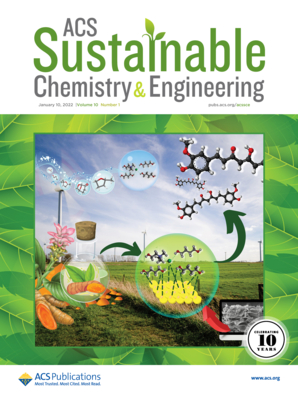Interiorly Hydrophobic Modification of Electrodeposited Self-supported ZnAg Foam Electrodes for CO2 Electroreduction in a Microchannel Reactor
IF 7.1
1区 化学
Q1 CHEMISTRY, MULTIDISCIPLINARY
引用次数: 0
Abstract
Electrodeposition is an effective approach to synthesize porous electrocatalysts; however, the impact of deposition conditions on the catalyst porosity and morphology has rarely been systematically studied. More importantly, the mass transport of CO2 is poor because the electrodes are generally fully covered by aqueous electrolytes, leading to low current densities. Hydrophobic modification can generate gas–liquid–solid interfaces that facilitate CO2 mass transport. However, the conventional superficially hydrophobic modification sacrifices the activity due to partially covered active sites, has difficulty in the uniform modification of internal pore surfaces due to large polymer size, and the surface hydrophobic sites are easily washed away. Here, we report a unique hydrogen bubble dynamic template electrodeposition method to synthesize interiorly hydrophobic ZnAg foam electrodes by physically trapping polytetrafluoroethylene (PTFE) during electrodeposition. Deposition conditions were found to influence the pore diameter and morphology. The pore diameter increases with the deposition current density and duration. The pore wall structure gradually transformed from nanodendrites at −0.5 A·cm–2 into nanosheets at −1 A·cm–2 or beyond. The resulting interiorly hydrophobic ZnAg(3A15s)-40 exhibits a maximum FECO of 97.6% and a significantly widened current density window of −5 to −50 mA·m–2 with an FECO of more than 90.4% in a microchannel reactor, which is significantly higher than those of bare ZnAg(3A15s) (−5 to −30 mA·cm–2 with an FECO more than 90.0%) and the Zn rod substrate (−5 mA·cm–2 with an FECO of 64.0%). The in situ attenuated total reflection Fourier transformed infrared (ATR-FTIR) spectroscopy suggested the hydrophobic catalyst has enhanced CO2 concentration near the inner surface, which promotes the activity of CO2 reduction to CO.

电沉积自支撑锌银泡沫电极的内部疏水性改性,用于微通道反应器中的二氧化碳电还原
电沉积是合成多孔电催化剂的有效方法;然而,沉积条件对催化剂孔隙率和形态的影响却很少得到系统研究。更重要的是,由于电极通常被水性电解质完全覆盖,导致电流密度较低,因此二氧化碳的质量传输较差。疏水改性可以产生气-液-固界面,从而促进二氧化碳的质量传输。然而,传统的表面疏水改性由于活性位点被部分覆盖而牺牲了活性,由于聚合物尺寸较大,难以均匀改性内部孔隙表面,而且表面疏水位点很容易被洗掉。在此,我们报告了一种独特的氢气泡动态模板电沉积方法,通过在电沉积过程中物理捕集聚四氟乙烯(PTFE)来合成内部疏水的泡沫锌铝电极。研究发现,沉积条件会影响孔径和形态。孔径随着沉积电流密度和持续时间的增加而增大。孔壁结构从-0.5 A-cm-2时的纳米树枝状逐渐转变为-1 A-cm-2或更高的纳米片状。在微通道反应器中,生成的内部疏水性 ZnAg(3A15s)-40 的最大 FECO 为 97.6%,电流密度窗口明显扩大,为 -5 至 -50 mA-m-2,FECO 超过 90.4%,明显高于裸 ZnAg(3A15s) (-5 至 -30 mA-cm-2,FECO 超过 90.0%)和 Zn 棒基底(-5 mA-cm-2,FECO 为 64.0%)。原位衰减全反射傅立叶变换红外光谱(ATR-FTIR)表明,疏水催化剂内表面附近的 CO2 浓度增加,从而提高了 CO2 还原成 CO 的活性。
本文章由计算机程序翻译,如有差异,请以英文原文为准。
求助全文
约1分钟内获得全文
求助全文
来源期刊

ACS Sustainable Chemistry & Engineering
CHEMISTRY, MULTIDISCIPLINARY-ENGINEERING, CHEMICAL
CiteScore
13.80
自引率
4.80%
发文量
1470
审稿时长
1.7 months
期刊介绍:
ACS Sustainable Chemistry & Engineering is a prestigious weekly peer-reviewed scientific journal published by the American Chemical Society. Dedicated to advancing the principles of green chemistry and green engineering, it covers a wide array of research topics including green chemistry, green engineering, biomass, alternative energy, and life cycle assessment.
The journal welcomes submissions in various formats, including Letters, Articles, Features, and Perspectives (Reviews), that address the challenges of sustainability in the chemical enterprise and contribute to the advancement of sustainable practices. Join us in shaping the future of sustainable chemistry and engineering.
 求助内容:
求助内容: 应助结果提醒方式:
应助结果提醒方式:


